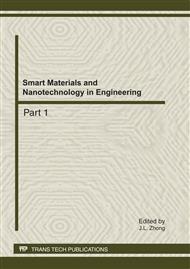[1]
C. Boisson-Vidal, et al, Biological activities of polysaccharides from marine algae, Drug Future, vol. 20, pp.1237-1249, (1995).
Google Scholar
[2]
Q. Zhang, et al, In vivo antioxidant activity of polysaccharide fraction from Porphyra haitanesis (Rhodephyta) in aging mice, Pharmacol Res, vol. 48, no. 2, pp.151-155, (2003).
DOI: 10.1016/s1043-6618(03)00103-8
Google Scholar
[3]
W.R.L. Farias, et al, Structure and anticoagulant activity of sulfated galactans. Isolation of a unique sulfated galactan from the red algae Botryocladia occidentalis and comparison of its anticoagulant action with that of sulfated galactans from invertebrates, J Biol Chem, vol. 275, no 38, pp.29299-29307, (2000).
DOI: 10.1074/jbc.m002422200
Google Scholar
[4]
X. L. Mao, Chinese Macrofungi, " He Nan: Science and Technology Press of He, nan, 2000, p.248. (Chinese).
Google Scholar
[5]
J. Cui, Z. L. Li, X. Y. Hong, Bio antioxidants with ill therapy, Journal of Tsinghua University (Science and Technology), vol. 40, no. 2, p.9, 2000. (Chinese).
Google Scholar
[6]
K. Z. Ye, et al, Extraction and Separation of Polysaccharide, Guangzhou Food Science and Technology, vol. 20, no. 3, pp.114-115, 2004. (Chinese).
Google Scholar
[7]
W. J. Zhang, Chemical investigation technique of Glycoconjugates, Shanghai: Science and Technology Press of Shanghai, 1987, pp.6-7. (Chinese).
Google Scholar
[8]
Q. X. Hu, C. Y. Gong, Y. M. Ji, Pholiota. adi posapose (Fr. ) Quel., Edible fungi new variety, and it's high grade and yield planting technology, China agricultural information, vol. 66, no. 3, pp.38-40, 2006. (Chinese).
Google Scholar
[9]
R. S. An, el at. Countercurrent and diverse phenomena of different concentration of chinese herbal medicine resisting free-radical, Journal of Chinese Medical Science, vol. 20, no. 8, p.507, 2005. (Chinese).
Google Scholar
[10]
A. E. Hagergerm an, K. M. Riedl, J. G. Alexander, High molecular weight plant polyphenolics as biological antioxidants, Agric Food Chem, vol. 46, no. 5, pp.1887-1891, (1998).
Google Scholar
[11]
S. R. Husain, J. Cillard, P. Cillard, Hydroxyl radical scavenging activity off lavonoids, Phytochemistry, vol. 26, no. 9, pp.2489-2492, (1987).
DOI: 10.1016/s0031-9422(00)83860-1
Google Scholar


